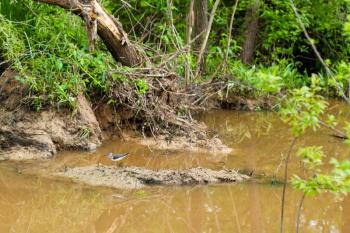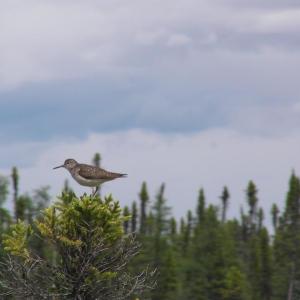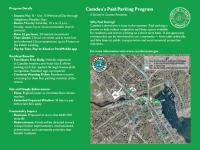The Wonderfully Mysterious Solitary Sandpiper
 On the breeding grounds in the Boreal Forest region of Canada and Alaska, the solitary sandpiper can be found in and near peatlands and shores of lakes and ponds. The bird in this photograph certainly had a nest somewhere nearby. Photo by Peuple Loup, courtesy of Wikimedia Commons
On the breeding grounds in the Boreal Forest region of Canada and Alaska, the solitary sandpiper can be found in and near peatlands and shores of lakes and ponds. The bird in this photograph certainly had a nest somewhere nearby. Photo by Peuple Loup, courtesy of Wikimedia Commons
 During migration, solitary sandpipers can often be found in small, muddy ditches and at ponds like this. Photo by Mellisa McMasters, courtesy of Wikimedia Commons
During migration, solitary sandpipers can often be found in small, muddy ditches and at ponds like this. Photo by Mellisa McMasters, courtesy of Wikimedia Commons
 Solitary sandpipers spend the winter months across the southern U.S., Mexico, the Caribbean, and Central and South America along the edges of freshwater marshes, ponds, ditches, and rivers. This one was photographed in Colombia. Photo by Felix Uribe, courtesy of Wikimedia Commons
Solitary sandpipers spend the winter months across the southern U.S., Mexico, the Caribbean, and Central and South America along the edges of freshwater marshes, ponds, ditches, and rivers. This one was photographed in Colombia. Photo by Felix Uribe, courtesy of Wikimedia Commons
 On the breeding grounds in the Boreal Forest region of Canada and Alaska, the solitary sandpiper can be found in and near peatlands and shores of lakes and ponds. The bird in this photograph certainly had a nest somewhere nearby. Photo by Peuple Loup, courtesy of Wikimedia Commons
On the breeding grounds in the Boreal Forest region of Canada and Alaska, the solitary sandpiper can be found in and near peatlands and shores of lakes and ponds. The bird in this photograph certainly had a nest somewhere nearby. Photo by Peuple Loup, courtesy of Wikimedia Commons
 During migration, solitary sandpipers can often be found in small, muddy ditches and at ponds like this. Photo by Mellisa McMasters, courtesy of Wikimedia Commons
During migration, solitary sandpipers can often be found in small, muddy ditches and at ponds like this. Photo by Mellisa McMasters, courtesy of Wikimedia Commons
 Solitary sandpipers spend the winter months across the southern U.S., Mexico, the Caribbean, and Central and South America along the edges of freshwater marshes, ponds, ditches, and rivers. This one was photographed in Colombia. Photo by Felix Uribe, courtesy of Wikimedia Commons
Solitary sandpipers spend the winter months across the southern U.S., Mexico, the Caribbean, and Central and South America along the edges of freshwater marshes, ponds, ditches, and rivers. This one was photographed in Colombia. Photo by Felix Uribe, courtesy of Wikimedia Commons
As we slide into August, the bird soundscape here in Maine undergoes a major change compared to May and June when the morning chorus of bird songs can seem deafening. Now there are periods of almost silence. True, the cicadas, crickets, grasshoppers, and other sound-producing insects are reaching the height of their contributions to our natural soundscape. But their mostly higher frequencies are more of a sizzle in the ear rather than the full-throated, all-encompassing caroling of five robins, three cardinals, two red-eyed vireos, a song sparrow, and a house finch—those are some of the birds producing the wall of sounds that may envelope you in a suburban neighborhood in Maine on a late May or early June morning.
The quietness of the birds in August is not because they have already migrated. In fact, there are likely more birds around in August than in early summer because of the many young birds that have joined the world over the past six weeks. The knowledge that there are a lot of birds around us but that they are essentially hidden away as compared to when they could be readily detected by their songs always makes them seem more mysterious.
From now through the fall, finding birds will require identifying them based on their more obscure calls rather than their songs or by getting a decent look if they’re not making any sound at all.
A few days ago, we were in the backyard when we heard the distinctive “peet-peet” call of a solitary sandpiper. That’s a call this species gives in flight or when startled. The bird passed over, repeatedly calling, but we could not locate it. Eventually, the sound grew weaker as it moved south in the sky. Then it was gone.
Solitary sandpipers are so named because they are unlike many of their fellow shorebirds species in the fact that they don’t typically travel in a flock. They also are not often found in coastal saltwater marshes, mudflats, or beaches. Solitary sandpipers seem to be most happy foraging for food in small, muddy ponds or ditches and along the shores of lakes and rivers.
The smaller close cousin to the lesser and greater yellowlegs, the solitary sandpiper, like those species, nests almost exclusively in the boreal forest region of Canada and Alaska and winter from the southern U.S. south to southern South America. They have another feature that is rare among the world’s shorebird species: They are one of only two species that nest in trees. Solitary sandpipers don’t make their own nests; they find an old nest of a robin, blackbird, Canada jay, waxwing, or other species and essentially recycle it in order to lay their 3-4 eggs. Like all shorebirds, the young are hatched fully feathered and leave the nest within hours.
There are huge gaps in our knowledge of the biology and ecology of solitary sandpipers because they nest in such remote areas and because they never occur in large numbers in any one location like many other shorebirds. Very few, apparently, have ever been tracked in migration. A single bird tagged near Cali, Colombia in April, 2024 made its way more than 1,800 miles north to the U.S. by early May, when it was detected at multiple MOTUS stations in Missouri and one in Iowa before the signal was lost.
Doesn’t it make you wonder what other great mysteries are yet to be revealed by the solitary sandpiper and so many other amazing birds?
Jeffrey V. Wells, Ph.D., is a Fellow of the Cornell Lab of Ornithology and Vice President of Boreal Conservation for National Audubon. Dr. Wells is one of the nation's leading bird experts and conservation biologists. He is a coauthor of the seminal “Birds of Maine” book and author of the “Birder’s Conservation Handbook.” His grandfather, the late John Chase, was a columnist for the Boothbay Register for many years. Allison Childs Wells, formerly of the Cornell Lab of Ornithology, is a senior director at the Natural Resources Council of Maine, a nonprofit membership organization working statewide to protect the nature of Maine. Both are widely published natural history writers and are the authors of the popular books, “Maine’s Favorite Birds” (Down East Books) and “Birds of Aruba, Bonaire, and Curaçao: A Site and Field Guide,” (Cornell University Press).



























